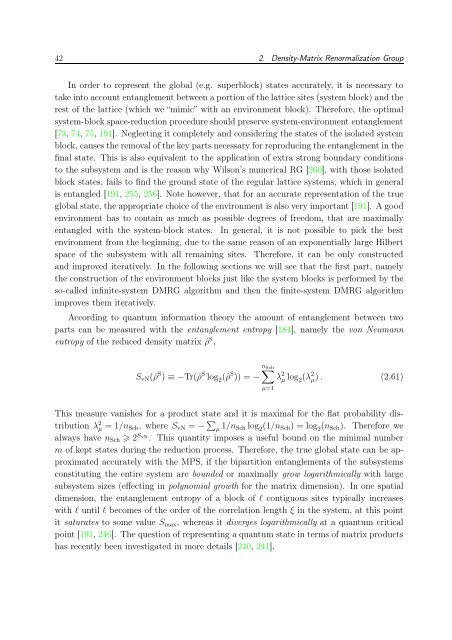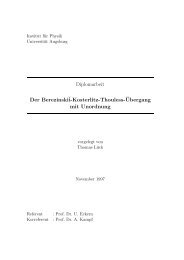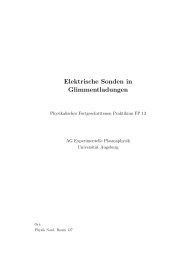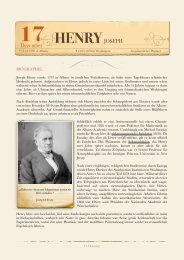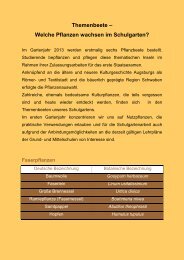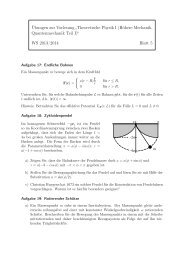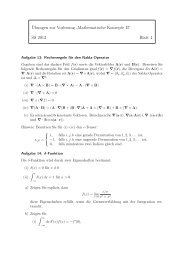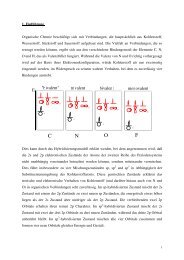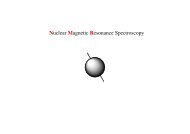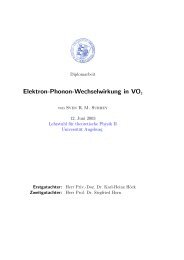PhD Thesis - Universität Augsburg
PhD Thesis - Universität Augsburg
PhD Thesis - Universität Augsburg
Create successful ePaper yourself
Turn your PDF publications into a flip-book with our unique Google optimized e-Paper software.
42 2. Density-Matrix Renormalization Group<br />
In order to represent the global (e.g. superblock) states accurately, it is necessary to<br />
take into account entanglement between a portion of the lattice sites (system block) and the<br />
rest of the lattice (which we “mimic” with an environment block). Therefore, the optimal<br />
system-block space-reduction procedure should preserve system-environment entanglement<br />
[73, 74, 75, 191]. Neglecting it completely and considering the states of the isolated system<br />
block, causes the removal of the key parts necessary for reproducing the entanglement in the<br />
final state. This is also equivalent to the application of extra strong boundary conditions<br />
to the subsystem and is the reason why Wilson’s numerical RG [260], with those isolated<br />
block states, fails to find the ground state of the regular lattice systems, which in general<br />
is entangled [191, 255, 256]. Note however, that for an accurate representation of the true<br />
global state, the appropriate choice of the environment is also very important [191]. A good<br />
environment has to contain as much as possible degrees of freedom, that are maximally<br />
entangled with the system-block states. In general, it is not possible to pick the best<br />
environment from the beginning, due to the same reason of an exponentially large Hilbert<br />
space of the subsystem with all remaining sites. Therefore, it can be only constructed<br />
and improved iteratively. In the following sections we will see that the first part, namely<br />
the construction of the environment blocks just like the system blocks is performed by the<br />
so-called infinite-system DMRG algorithm and then the finite-system DMRG algorithm<br />
improves them iteratively.<br />
According to quantum information theory the amount of entanglement between two<br />
parts can be measured with the entanglement entropy [184], namely the von Neumann<br />
entropy of the reduced density matrix ˆρ S ,<br />
∑n Sch<br />
S vN (ˆρ S ) ≡ −Tr(ˆρ S log 2 (ˆρ S )) = − λ 2 µ log 2(λ 2 µ ) . (2.61)<br />
µ=1<br />
This measure vanishes for a product state and it is maximal for the flat probability distribution<br />
λ 2 µ = 1/n Sch, where S vN = − ∑ µ 1/n Sch log 2 (1/n Sch ) = log 2 (n Sch ). Therefore we<br />
always have n Sch 2 S vN<br />
. This quantity imposes a useful bound on the minimal number<br />
m of kept states during the reduction process. Therefore, the true global state can be approximated<br />
accurately with the MPS, if the bipartition entanglements of the subsystems<br />
constituting the entire system are bounded or maximally grow logarithmically with large<br />
subsystem sizes (effecting in polynomial growth for the matrix dimension). In one spatial<br />
dimension, the entanglement entropy of a block of l contiguous sites typically increases<br />
with l until l becomes of the order of the correlation length ξ in the system, at this point<br />
it saturates to some value S max , whereas it diverges logarithmically at a quantum critical<br />
point [191, 246]. The question of representing a quantum state in terms of matrix products<br />
has recently been investigated in more details [240, 241].


